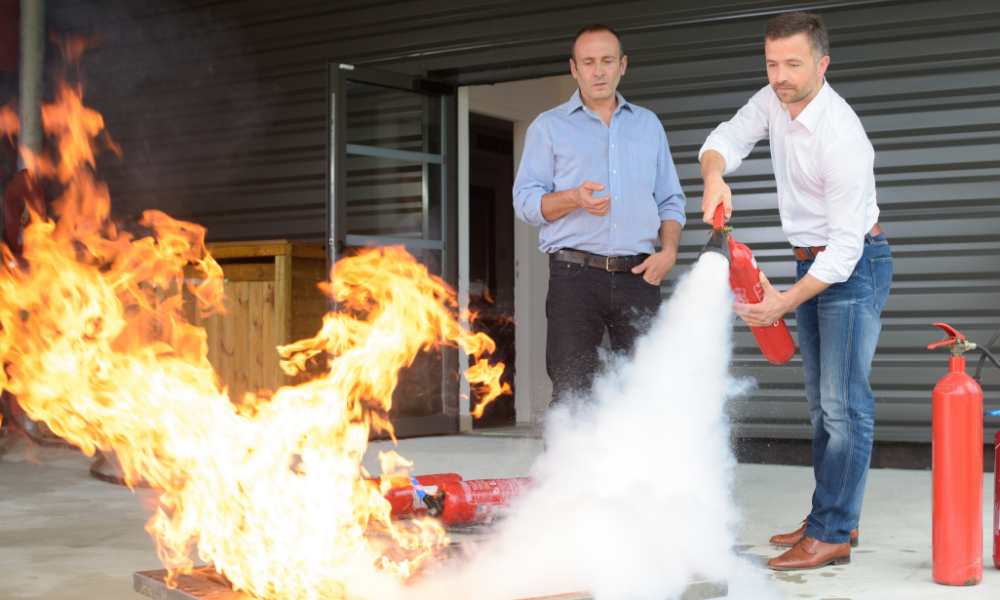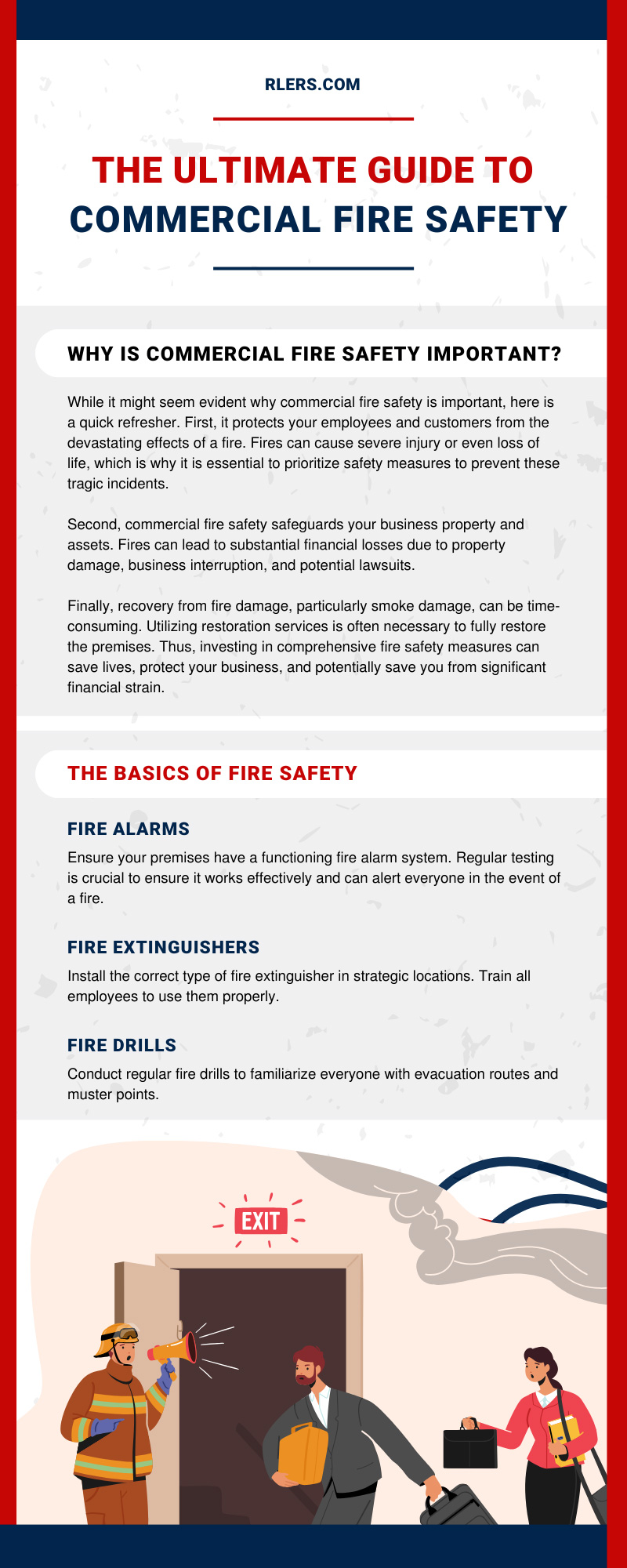
As a commercial business owner, you know how important it is to keep employees, customers, and your building safe; fire safety is no exception. You can take many steps to ensure everyone in your building knows what to do in the event of a fire, from understanding fire regulations to emergency evacuation plans.
Therefore, we put together this ultimate guide to commercial fire safety, so you can stay up-to-date on the best practices for protecting your workforce and property. This guide provides all the essential information you need for creating a safe environment at your workplace, whether you’re just getting started or looking for new ways to improve existing processes.
Why Is Commercial Fire Safety Important?
While it might seem evident why commercial fire safety is important, here is a quick refresher. First, it protects your employees and customers from the devastating effects of a fire. Fires can cause severe injury or even loss of life, which is why it is essential to prioritize safety measures to prevent these tragic incidents.
Second, commercial fire safety safeguards your business property and assets. Fires can lead to substantial financial losses due to property damage, business interruption, and potential lawsuits.
Finally, recovery from fire damage, particularly smoke damage, can be time-consuming. Utilizing restoration services is often necessary to fully restore the premises. Thus, investing in comprehensive fire safety measures can save lives, protect your business, and potentially save you from significant financial strain.
The Basics of Fire Safety
Fire safety is primarily about prevention. Erecting fire barriers, installing fire doors, and using flame-retardant materials in construction are all proactive measures. However, you must underpin these physical measures with a robust fire safety protocol. Here are a few basics of fire safety:
Fire Alarms
Ensure your premises have a functioning fire alarm system. Regular testing is crucial to ensure it works effectively and can alert everyone in the event of a fire.
Fire Extinguishers
Install the correct type of fire extinguisher in strategic locations. Train all employees to use them properly.
Fire Drills
Conduct regular fire drills to familiarize everyone with evacuation routes and muster points.
Emergency Lighting
Install emergency lighting to help guide individuals to safety in case of a power outage during a fire.
Fire Safety Training
Educate your employees about fire hazards, prevention strategies, and what to do in case of a fire.
6. Maintenance
Regular checks and maintenance of equipment and the premises can help prevent fires.
Smoke Detectors
Install smoke detectors in key areas and ensure they are functional.
Understanding Fire Regulations for Commercial Buildings
Both federal and local codes govern fire regulations for commercial buildings and encompass a broad range of requirements to mitigate the risks and potential impacts of fire events. These regulations include stipulations on the design and layout of the building, the installation of fire safety systems, such as alarms and sprinklers, and the maintenance of exit pathways and signage.
Non-compliance with these regulations can lead to heavy penalties, including fines and legal action. Therefore, staying informed about the specific regulations applicable to your location and type of business is crucial.
Regularly Test and Inspect the Commercial Property
Regular inspections and tests of your commercial property are crucial to ensuring all fire safety measures are functioning as intended and that there are no potential fire hazards. These inspections involve testing fire alarms, smoke detectors, and fire extinguishers periodically to ensure they are operational. Similarly, you must also check emergency exit signs and lighting systems to ensure they are in working order.
We recommend performing these tests and inspections at least twice a year, but more frequent checks might be necessary depending on the nature of your business and local regulations. Remember, regular maintenance not only helps in fire prevention but also aids in minimizing damage, proving beneficial when needing smoke damage restoration services or other similar services.
Identify Potential Hazards
Identifying potential fire hazards in your commercial building is a crucial step toward fire prevention. Unnoticed risks can escalate into a full-blown fire if neglected, potentially causing extensive damage to your property, disrupting your business, and posing a serious threat to the lives of employees and customers.
Recognizing these hazards involves a meticulous examination of your business premises. Look for common fire risks such as faulty electrical wiring, overheating equipment, or improper storage of flammable chemicals or materials. Regularly monitor areas that generate heat, like kitchens or industrial manufacturing spaces.
Also, ensure your teams properly dispose of waste materials, as accumulated waste can provide rapid fuel for a fire. Consolidating these proactive steps into your fire safety strategy can significantly reduce the need for restoration services and, more importantly, protect lives.
Invest in Fire Protection Equipment
Investing in fire protection equipment is critical to a comprehensive fire safety strategy. High-quality fire safety equipment such as fire extinguishers, smoke detectors, fire alarms, and sprinkler systems can significantly reduce the spread of fire, providing valuable time for evacuation and minimizing property damage.
Furthermore, fire safety equipment can help prevent the ignition of small fires, curbing them before they escalate into larger, more destructive blazes. Having appropriate fire safety equipment on hand, in turn, reduces the scope and cost of post-fire recovery.
Establish an Emergency Evacuation Plan
Establishing an emergency evacuation plan is vital to ensure quick and safe egress from your premises during a fire event. This plan outlines the best and fastest routes to exit the building, muster points to gather in after evacuation, and key roles and responsibilities during the process.
Thoroughly inspect your property and identify all possible exits to create an evacuation plan. Draw a floor plan indicating these exits and the quickest routes leading to them. You should clearly communicate and frequently rehearse this plan with all employees to ensure they are well-versed in the procedure.
Remember to consider employees and customers with disabilities and those requiring accommodations in your plan and assign specific individuals to assist them. A well-thought-out and practiced evacuation plan can save precious minutes during a fire, potentially saving lives and reducing the extent of damage.
This ultimate guide to commercial fire safety is your one-stop source for understanding and implementing robust fire prevention measures in your commercial premises. We hope the information provided will equip you with the necessary knowledge to put effective safeguards in place, keeping your employees, customers, and assets protected.
Remember, safety should always be your top priority. Let’s make safety a culture, not just a checklist. Reach out to Redline Emergency Solutions if you need restoration services in the future. Our professional staff is ready with the knowledge and tools to restore your property to its former glory.


